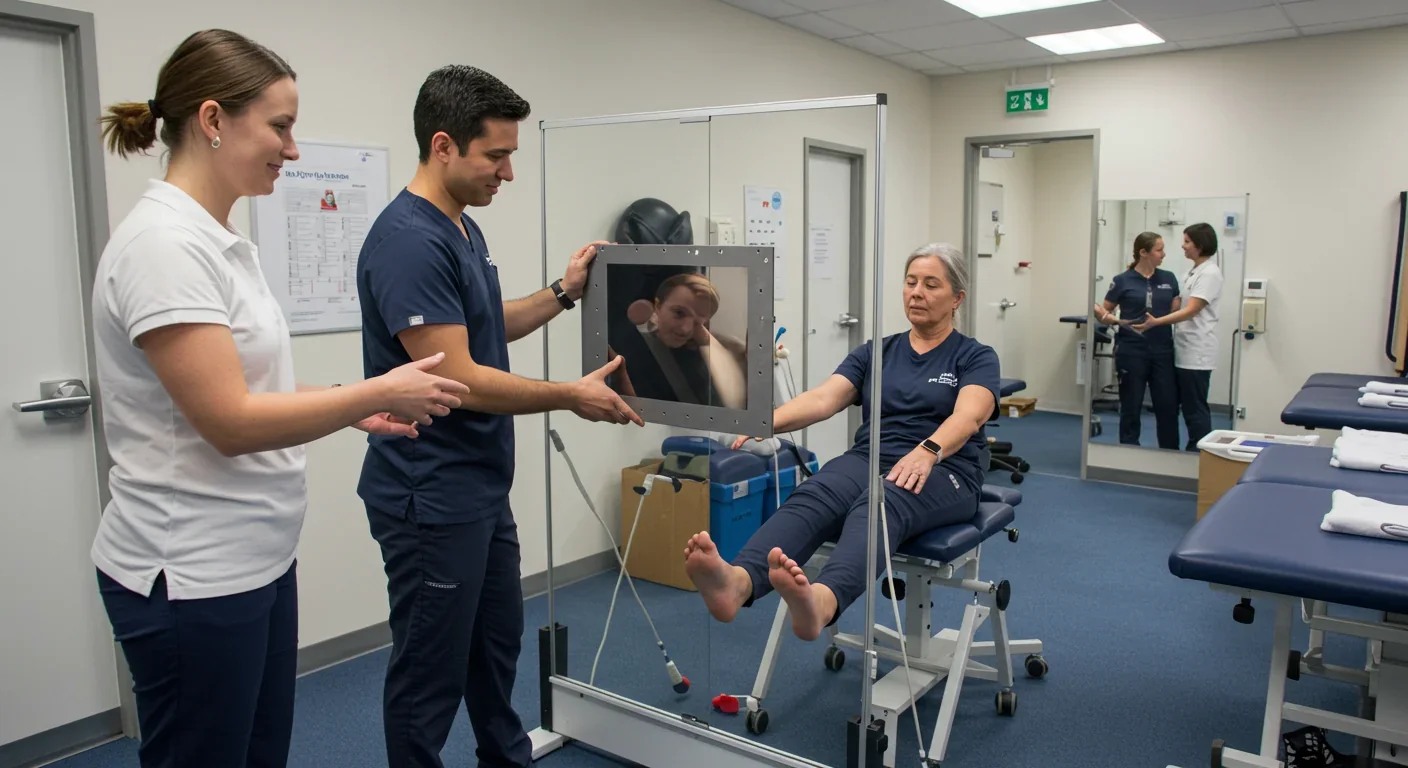Why Your Brain Is Hardwired to Lose Money

TL;DR: Mirror neurons fire when we act and when we observe others acting, creating the biological foundation for empathy by allowing our brains to simulate others' experiences at a neural level.

Picture this: You're watching a friend accidentally slam their finger in a door, and you wince. That automatic response isn't just sympathy. It's your brain literally simulating their pain through specialized cells called mirror neurons. These remarkable brain cells fire both when you perform an action and when you watch someone else do the same thing. They're the biological foundation of empathy, and they're reshaping how we understand human connection.
In the early 1990s, a team of Italian researchers at the University of Parma stumbled onto something extraordinary. They were studying motor control in macaque monkeys, mapping which neurons fired when the animals reached for food. Then one day, a researcher grabbed a peanut, and the equipment went wild. The monkey's brain lit up as if it were reaching for the peanut itself, even though the animal was just watching.
The discovery was so unexpected that the team initially thought their equipment had malfunctioned. But after months of verification, they published their findings in 1992. These cells, located in the premotor cortex, became active during both action and observation of the same action. They called them mirror neurons, and the name stuck.
What made this discovery remarkable wasn't just the existence of these cells. It was what they implied: our brains don't just passively observe the world. They actively simulate the experiences of others at a neurological level. When you watch someone smile, your mirror neurons for smiling activate. When you see someone lift a cup, your mirror neurons for that exact movement fire up.
Mirror neurons work through a process called motor resonance. When you observe an action, specific neurons in your premotor cortex and inferior parietal lobule activate as if you were performing that action yourself. This isn't imagination or conscious effort. It happens automatically, below the threshold of awareness.
Recent studies using transcranial magnetic stimulation have measured this phenomenon with precision. When participants watched someone press a button, their corticospinal excitability increased by 34.80% compared to just 7.23% when viewing a static hand. The brain was literally preparing to perform the observed action.
But mirror neurons don't just encode physical movements. They capture intent and emotion too. Research shows these cells activate differently depending on whether someone is grasping a cup to drink from it or to move it. The context matters. Your brain isn't just mirroring actions; it's reading minds in real time, predicting goals and emotional states based on observed behavior.
This neural mirroring extends to emotions. See someone grimace in disgust, and your insula lights up with similar activity patterns. Watch a person cry, and regions associated with sadness activate in your own brain. You're not just understanding their feelings intellectually. You're experiencing a diluted version of their emotional state through your mirror neuron system.
Proving mirror neurons exist in humans has been trickier than in monkeys. You can't just stick electrodes into human brains for curiosity's sake. Instead, researchers have relied on neuroimaging techniques like fMRI and EEG, along with behavioral studies that reveal mirror neuron activity indirectly.
One breakthrough came from measuring motor-evoked potentials during action observation. Scientists found that watching someone perform a learned motor skill increased brain activity in the same regions used to perform that skill. The better you are at a task, the stronger your mirror response when watching someone else do it.
Neuroscientist V.S. Ramachandran called mirror neurons "the driving force behind the great leap forward in human evolution" because they enabled imitation, a cornerstone of culture and learning. He suggested these cells accelerated human development by allowing rapid transmission of skills and knowledge across generations without genetic changes.

But the evidence for human mirror neurons isn't universally accepted. Some researchers argue that the indirect measurements don't prove the existence of neurons with true mirror properties. They point out that fMRI studies show activity in regions, not individual cells, and that correlation doesn't equal causation. The debate continues, with most neuroscientists accepting that mirror neuron-like mechanisms exist in humans, even if the exact cellular architecture remains unclear.
Here's where things get fascinating for anyone interested in human connection. Mirror neurons appear to be the biological substrate of empathy. They allow you to understand others not through logical deduction but through direct neural simulation.
Studies have shown that when you watch someone experiencing an emotion, your brain activates similar emotional circuits. This creates what researchers call "neurological resonance." During a deep conversation with a friend sharing their feelings, your mirror neurons create a bridge between their experience and yours, helping you grasp both their perspective and your own reactions to it.
This has profound implications for understanding conditions like autism spectrum disorder, where social connection can be challenging. Some early research suggested that autism might involve mirror neuron dysfunction, though this hypothesis has been challenged and refined over the years. The relationship between mirror neurons and autism is now understood to be complex, involving differences in how these systems connect with other brain networks rather than simple deficits.
Clinical applications are already emerging. Therapists use mirror neuron principles in treatment approaches that involve modeling behaviors or using video feedback. The idea is that watching and then imitating adaptive behaviors activates neural pathways that make those behaviors easier to adopt.
Social skills training programs increasingly incorporate observation-based learning, leveraging mirror neuron activation to help people develop better interpersonal abilities. By carefully observing positive social interactions, participants can activate the neural circuitry needed to perform those behaviors themselves.
One of the most surprising applications of mirror neuron research is in artificial intelligence. Engineers are creating AI systems that align representations of observed actions with the neural patterns for executing those actions, mimicking how biological mirror neurons work.
These systems use what's called embodied representation alignment. They train neural networks to develop similar internal representations whether the network is observing an action or performing it. In recent experiments, this approach improved robotic manipulation success rates by 3.5% across 18 different tasks. That might sound modest, but in robotics, it's significant.
More intriguingly, this research suggests that representation alignment emerges spontaneously during training and correlates with better task performance. The AI systems are essentially developing artificial empathy, a capacity to understand actions by internally simulating them. This mirrors exactly what biological mirror neurons do.
The implications extend beyond robotics. As AI systems interact more with humans, especially in caregiving, education, or therapy contexts, having AI that can recognize and respond to human actions and emotions through mirror-like mechanisms could create more natural, effective interactions. We're teaching machines to walk in our neural shoes.
Despite decades of research, mirror neurons remain controversial in neuroscience. The biggest debate centers on whether humans actually have mirror neurons in the strict sense, single cells that fire both during action and observation.
Critics point out that much of the human evidence comes from population-level brain imaging, not single-cell recordings. They argue that observing activity in a brain region doesn't prove that individual neurons within that region have mirror properties. Some suggest that what we're seeing might be separate populations of neurons, some for action and some for observation, that happen to live in the same neighborhood.
There's also debate about how much mirror neurons actually contribute to empathy and social cognition. While correlation exists, establishing causation is tricky. Some researchers believe mirror neurons are just one piece of a much larger, more complex empathy network that includes emotional processing centers, theory of mind circuits, and top-down cognitive control.

Another open question involves individual differences. Why do some people seem naturally more empathetic than others? Is it because their mirror neuron systems are more active or better connected? Research on this is in early stages, but it could eventually help explain personality variations and inform targeted interventions for people who struggle with social understanding.
Understanding mirror neurons offers practical insights for everyday life. First, you can deliberately cultivate empathy by engaging with diverse perspectives and experiences. Watching documentaries, reading fiction, or simply having conversations with people different from you all activate your mirror neuron system, strengthening these neural pathways.
Second, mindful mirroring during conversations can enhance connection. Subtly matching a conversation partner's posture and speaking pace activates mirror neurons and creates rapport. You're not manipulating; you're working with your brain's natural empathy machinery.
Third, observation matters for learning. If you're trying to master a new skill, watching experts perform it activates the same neural circuits you'll use when practicing. This doesn't replace hands-on practice, but it primes your brain, making actual learning more efficient. Athletes have known this intuitively for years; neuroscience now explains why visualization works.
For parents and educators, creating opportunities for children to observe positive social behaviors activates their developing mirror neuron systems. Kids learn empathy not just through instruction but through watching adults navigate social situations with kindness and emotional intelligence. Your behavior is contagious at a neural level.
The next frontier involves understanding how mirror neurons connect with other brain systems. Researchers are mapping the circuits that link mirror neurons to emotional centers like the amygdala and to higher cognitive regions involved in perspective-taking and moral reasoning.
Advanced brain imaging techniques are getting closer to identifying mirror neurons at the cellular level in humans. New methods that combine multiple imaging approaches might finally settle the debate about whether humans have true mirror neurons or something functionally similar but structurally different.
Clinical applications are expanding. Scientists are exploring whether targeted mirror neuron training could help people with social cognitive challenges, including those on the autism spectrum, individuals with schizophrenia, and people recovering from trauma. Early results suggest that interventions designed to enhance mirror neuron function can improve social abilities.
The intersection of mirror neuron research and AI ethics is heating up too. As we build machines with empathy-like capabilities, questions arise about machine consciousness, moral status, and the potential risks of emotionally intelligent AI. If a robot can simulate understanding your feelings through mirror-like mechanisms, does that change our obligations to it?
Mirror neurons represent one of neuroscience's most elegant discoveries: a biological mechanism that literally allows you to feel what others feel and understand what they're doing by internally replicating their neural states. They're the hardware behind humanity's capacity for culture, cooperation, and compassion.
In a world that often feels fragmented and polarized, understanding the neuroscience of empathy offers hope. We're not just locked in our own heads, making guesses about others' internal lives. We're wired to connect, to simulate and share experiences at the most fundamental neural level. Every interaction activates this ancient empathy machinery, creating tiny moments of shared understanding.
The science also suggests that empathy isn't fixed. Like any neural system, mirror neuron networks can be strengthened through use or weakened through neglect. That means building a more empathetic society isn't just about good intentions. It's about creating environments and practices that consistently activate these neural bridges between minds.
As research continues, we'll likely discover that mirror neurons are even more versatile than we currently understand. They might play roles in language acquisition, moral development, and aesthetic appreciation. They might help explain why music moves us, why stories captivate us, and why watching someone yawn makes you yawn too.
For now, knowing these cells exist offers both explanation and inspiration. The next time you automatically mirror someone's smile or wince at their pain, remember: that's not weakness or oversensitivity. That's your brain doing exactly what millions of years of evolution designed it to do—building bridges of understanding, one neural firing at a time.

MOND proposes gravity changes at low accelerations, explaining galaxy rotation without dark matter. While it predicts thousands of galaxies correctly, it struggles with clusters and cosmology, keeping the dark matter debate alive.

Ultrafine pollution particles smaller than 100 nanometers can bypass the blood-brain barrier through the olfactory nerve and bloodstream, depositing in brain tissue where they trigger neuroinflammation linked to dementia and neurological disorders, yet remain completely unregulated by current air quality standards.

CAES stores excess renewable energy by compressing air in underground caverns, then releases it through turbines during peak demand. New advanced adiabatic systems achieve 70%+ efficiency, making this decades-old technology suddenly competitive for long-duration grid storage.

Our brains are hardwired to see patterns in randomness, causing the gambler's fallacy—the mistaken belief that past random events influence future probabilities. This cognitive bias costs people millions in casinos, investments, and daily decisions.

Forests operate as synchronized living systems with molecular clocks that coordinate metabolism from individual cells to entire ecosystems, creating rhythmic patterns that affect global carbon cycles and climate feedback loops.

Generation Z is the first cohort to come of age amid a polycrisis - interconnected global failures spanning climate, economy, democracy, and health. This cascading reality is fundamentally reshaping how young people think, plan their lives, and organize for change.

Zero-trust security eliminates implicit network trust by requiring continuous verification of every access request. Organizations are rapidly adopting this architecture to address cloud computing, remote work, and sophisticated threats that rendered perimeter defenses obsolete.